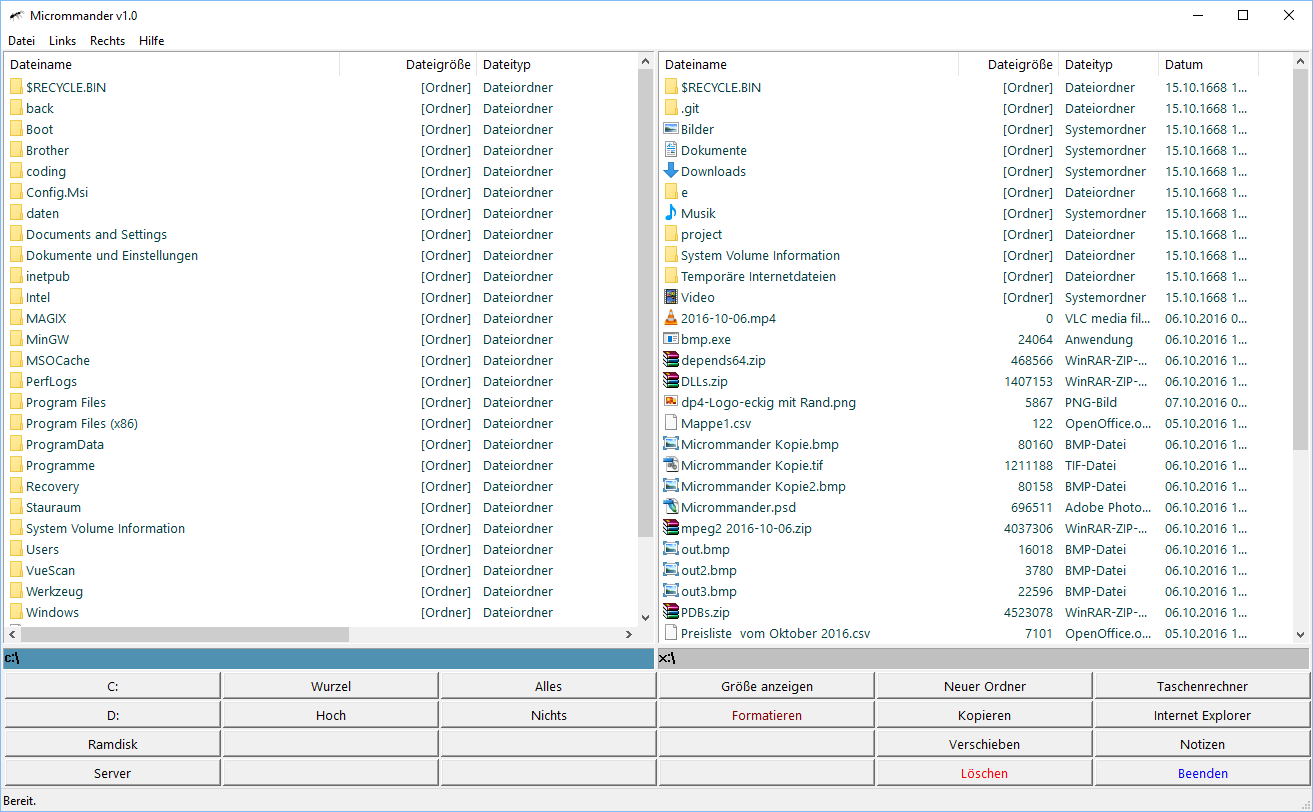
Introduction
This tool is a simple 64 bit file manager for Windows featuring a 100% assembly language source code. The tool shall be a sample for using advanced techniques in assembly language environment, like native 64 bit, object orientation and unwind ability for stack frames.
Wait, Assembly Language? Isn't It Dead Already?
No, it's not. While programming languages are getting more and more high level, assembly language is still the base of each and every modern device, smart phone, tablet, desktop or server. If you understand assembly language, each other language will be just a new set of syntax elements and a couple of interesting new concepts.
There is probably no useful reason to do a large project in assembly, but every programmer should at least have an idea of what is going on under the hood.
How Will Assembly Language Be Able to Use Modern Techniques as OOP?
Most of the common programming paradigms are not a property of the language, but a way how to write source code. The language can give you support to avoid mistakes and make writing easily, however you can still do it on your own.
This project features a fully object orientated style, multi threaded working and all the Windows features for x64 programs.
How to Work with Assembly Language?
Visual Studio 2013 contains the MASM (Microsoft Macro Assembler) which will be able to assemble the source files out of the box. If you encounter any problems with the project, please don't hesitate to contact.
For better layout of the ASM sources, we use a VStudio plug in for formatting the source code. This will become a sub project in near future (hopefully). Currently, the plug in is not worth a public release.
Using the Code
Some interesting code snippets:
actSetProgress PROC FRAME
LOCAL hwndList:QWORD
LOCAL xItem:LVITEM
LOCAL txBuffer [128]:WORD
LOCAL xRange:PBRANGE
push rbp
.pushreg rbp
push r12
.pushreg r12
push r15
.pushreg r15
mov rbp, rsp
.setframe rbp, 0
sub rsp, 8 + 2 * 128 + sizeof LVITEM + sizeof PBRANGE
sub rsp, 48
.allocstack 48 + 8 + 2 * 128 + sizeof LVITEM + sizeof PBRANGE
.endprolog
aspDone: mov rax, 0
add rsp, 48
add rsp, 8 + 2 * 128 + sizeof LVITEM + sizeof PBRANGE
pop r15
pop r12
pop rbp
ret 0
align 4
Procedure starts with PROC FRAME, since MASM cannot declare parameters in x64 mode nothing follows.
Afterwards local variables are declared, with appropriate data types. Used registers should be pushed and popped manually and declared to be so with .pushreg keyword. Space for variables must be allocated manually too and also space for any call usage inside this procedure (sub rsp, 48 in this example). Stack usage is declared with .allocstack. Since all calls are register based, stack must be corrected on return and use ret 0. Finally, the header end with .endprolog.
You must care about alignment of stack to be 8 bytes. Code should be aligned on 4.
Calling a register based function:
lea rax, [r15.VIEW_PARAM.txFontName]
mov [rsp + 104], rax
mov dword ptr [rsp + 96], DEFAULT_PITCH OR FF_DONTCARE
mov dword ptr [rsp + 88], DEFAULT_QUALITY
mov dword ptr [rsp + 80], CLIP_DEFAULT_PRECIS
mov dword ptr [rsp + 72], OUT_DEFAULT_PRECIS
mov dword ptr [rsp + 64], DEFAULT_CHARSET
mov dword ptr [rsp + 56], FALSE
mov dword ptr [rsp + 48], FALSE
mov eax, dword ptr [r15.VIEW_PARAM.unItalic]
mov dword ptr [rsp + 40], eax
mov eax, dword ptr [r15.VIEW_PARAM.unWeight]
mov dword ptr [rsp + 32], eax
mov r9d, 0
mov r8d, 0
mov edx, 0
mov ecx, dword ptr [r15.VIEW_PARAM.unFontSize]
call CreateFont
Registers rcx, rdx, r8 and r9 hold first four parameters. If more are required, they are placed on the stack. Keep space for first 64 bit parameters, as the procedure can write parameters back on stack if required.
Doing Basic Object Orientation
Each object has to be a small allocated memory block. It contains a list of the methods it defines (vtable), which will be always the first member in block. If you share this table between objects, it represents the difference between class and object. If you change methods in list, it be some kind of overload or inheritance.
Generate a new object via handmade new operation:
buttonNew PROC FRAME
...
call GetProcessHeap
test rax, rax
jz btnExit
mov r8, sizeof CLASS_BUTTON
mov edx, HEAP_ZERO_MEMORY
mov rcx, rax
call HeapAlloc
test rax, rax
jz btnExit
lea rcx, [rax.CLASS_BUTTON.xInterface]
mov [rax.CLASS_BUTTON.vtableThis], rcx
lea rdx, btnInit
mov [rcx.CLASS_BUTTON_IFACE.pfnInit], rdx
lea rdx, btnLoadConfig
mov [rcx.CLASS_BUTTON_IFACE.pfnLoadConfig], rdx
lea rdx, btnSaveConfig
mov [rcx.CLASS_BUTTON_IFACE.pfnSaveConfig], rdx
lea rdx, btnGetRect
mov [rcx.CLASS_BUTTON_IFACE.pfnGetRect], rdx
lea rdx, btnRender
mov [rcx.CLASS_BUTTON_IFACE.pfnRender], rdx
Objects size is allocated at process heap. The table with method pointers resists inside object data. All pointers are written to the table and the table pointer is filled into first position.
Sample class definition:
CLASS_BUTTON_IFACE struc
pfnInit dq ?
pfnLoadConfig dq ?
pfnSaveConfig dq ?
pfnGetRect dq ?
pfnRender dq ?
CLASS_BUTTON_IFACE ends
CLASS_BUTTON struc
vtableThis dq ?
pxApp dq ?
unCmd dq ?
txText dw 32 dup(?)
txParam dw DEF_PATH_LENGTH dup(?)
xParams VIEW_PARAM
unShortcut dq ?
unCol dq ?
unRow dq ?
txSection dw 64 dup(?)
xInterface CLASS_BUTTON_IFACE
CLASS_BUTTON ends
If the class is defined this way and kept properly aligned to 8 bytes, it will be fully compatible to Visual Studio C++ classes, so you can even interact with a C++ object or call assembly methods from C++.
Calling an object method (MS style, aka STDMETHODCALL):
lea r9, txTitle
mov r8, [r12.CLASS_APP.unLang]
mov rdx, IDS_ABOUT_TITLE
mov rcx, r12
mov rax, [r12.CLASS_APP.vtableThis]
call [rax.CLASS_APP_IFACE.pfnLoadString]
Object has to be in rcx register, rax holds the vtable pointer, and the call goes to wanted method inside vtable.
History
- October 2016: First release
